|
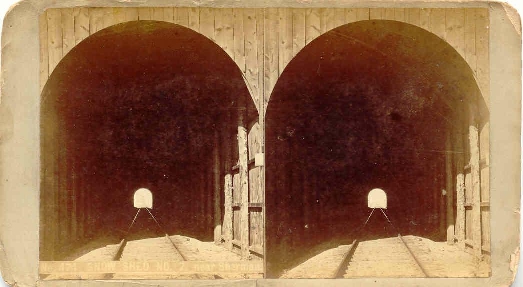
Snowshed, Sherman Hill, Stereograph by
Charles Weitfle
From the beginning of the railroad, difficulties with snow was a major problem. Pictured to the lower
right is a photo of a locomotive stuck in the snow. The photo, itself, is mislabeled and was
taken in March of 1869. Passengers included some dignitaries on their way to
Washington for President Grant's inaugural. the solution, adopted from almost the beginning was the
construction of snow sheds.
In January 1872, Susan B. Anthony travelled across the continent by train. After a stop in
Laramie, on January 1, she boarded the train to Cheyenne. With the snow on Sherman Hill, the train took five days including over a day
stopped in a snow tunnel. Miss Anthony wrote:
January 2. —Still stationary. The railroad company has supplied the passengers
with dried fish and crackers. Mrs. Sargent and I have made tea and
carried it throughout the train to the nursing mothers. It is the best we can
do. Five days out from Ogden! This is indeed a fearful ordeal, fastened
here in a snowbank, midway of the continent at the top of the Rocky mountains.
They are melting snow for the boilers and for drinking water. A train
loaded with coal is behind us, so there is no danger of our suffering from
cold.
* * * *
The train had
moved up to Dale Creek bridge and drawn into a long snow-shed. Here we
remained all night and, with the rarified air and the smoke from the engine,
were almost suffocated, while the wind blew so furiously we could not venture
to open the doors.
* * * *
January 4.—Morning found us still at Sherman and we did not move till 1 P. M.
There is another train ahead of us, and here we are, four passenger trains
pushing on for Cheyenne. The people from the different ones visit among
each other. Half-way to Granite Canyon the snowplow got off the track and
one wheel broke, so a dead standstill for hours. Reached Granite Canyon at
dark, a whole day getting there from Sherman, and remained over night.
January 5.—Bright and beautiful. Reached Cheyenne at 11:30 A. M
The Polish author Henryk Sienkiewicz in his
Listy z podozy do Ameryki, "Letters and Portraits from America," Gazeta Polska, 1876, described
the snowshed on Sherman Hill:
We were approaching Cheyenne, a station in Wyoming, but before
reaching it we rode through the first snowshed, which was more than
a mile long. these snowsheds are extremely long galleries covered by a roof to protect the railroad
tracks from snowdirfts. I had heard so many tales and so much wonder about them that
I admit complete disappointment. It is true that these
galleries are very long, but also that they are nailed together of planks and
beams in the crudest manner. The beams are held together by nails -- in the roof
a multitude of holes -- in a word, the whole thing was built the way we used
to build houses a few decades ago. Although construction of this type can be
absolutely adequate, in no case does it warrant being regarded as the
eighth wonder of the world.
Sienkiewicz is today remembered as the author of Quo Vadis.
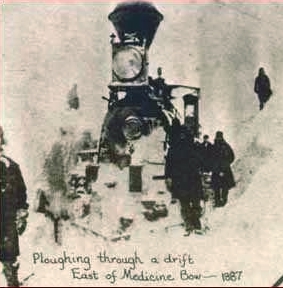
Train Stuck in Snow on Laramie Plains, 1869, photo by
C. R. Savage
As noted above, the caption on the photo is in error. The photo was actually taken in 1869, and was
apparently used as a later stock photo for a news story in 1887. Charles Weitfle (1836-1921), came to the
United States at age 13. He served as a photographer for the Union Army. In 1878,
he established a studio in Central City, Colo. and later had a studio in Denver. In 1883, his Denver Studio
burned, destroying approximately 1,000 plates. He then established a tent
studio in Cheyenne and also maintain a studio in Rawlins. About 1887-1889, Weitfle moved to
Granite County, Mont. and later to Phillipsburg. His son, Paul Weitfle, was also a
photographer in Colorado and New Mexico, but the two were estranged. [The writer gratefully acknowledes the
assistance of Paul Weitfle III for information concerning his great-grandfather.]
Snow has remained a problem. The winter of 1916-1917 was especially bad. In
late January, 1917, traffic on the road between Hanna and Laramie was interdicted by snow drifts
which the rotaries were unable to clear. The January 29 issue of the Laramie Boomerang reported that
the previous night fourteen dead engines were brought into the yard from
Rock River, most out of coal and all out of water. The paper continued:
It was reported at noon today that the plows, assisted by laborers, had
cleared one track long enough to get one train through to Hanna. However, the
tracks were drifted again shortly afterwards and two snow plows were
working to get another train through. Eastbound trains, however, are almost
hopelessly marooned. there has not been a regular passenger train from the west
since early Saturday morning and there is no telling when one will
get through. The drifting lets up at times for about an hour, but just about the
time a train is to be piloted through the wind comes up again and does
away with all the previous work.
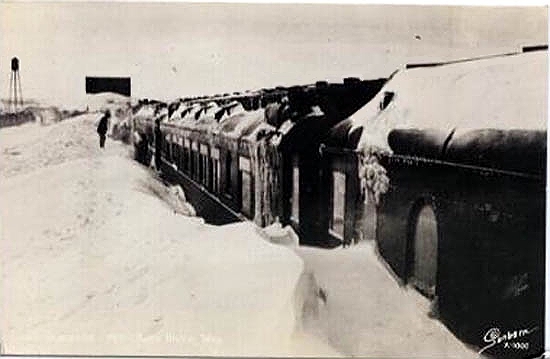
Train Stuck in Snow, Rock River, January 1917
[Writer's note: The Daily Boomerang is probably the only newspaper named after a
mule. In first publisher, Edgar Wilson "Bill" Nye (1850-1896), founded the
paper in 1881, and named the paper after his mule "Boomerang." Two versions are given for
the naming of the mule: (a) the mule would follow Nye into a bar and would be shooed out. However,
the mule would return "like a boomerang;" and (b) the mule would leave its stable and
disappear for a few days, but would return "like a boomerang."]
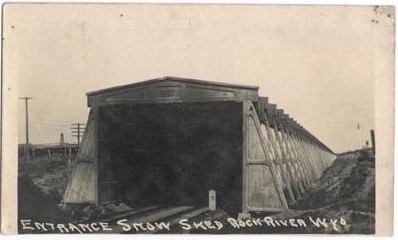 Snowshed at Rock River
Snowshed at Rock River
Note date over portal to snowshed, 1917. As a result of the difficulties in
1917, the Railroad established a plant at Rock River for making precast panels for
snowsheds. Prior to that time, snowsheds were constructed on an as needed basis, thus,
perhaps explaining the crude construction observed by Henryk Sienkiewicz. The plant
at Rock River is now gone.
Of course, it is possible that writers were impressed with the early snowsheds, because they were less than
impressed with the scenery. Robert Louis Stevenson in his Across the Plains, Chattus & Windus, London, 1892), describes
the scenery near Sherman Hill:
To cross such a plain is to grow homesick for the mountains. I longed for the
Black Hills of Wyoming, which I knew we were soon to enter, like an ice-bound
whaler for the spring. Alas! and it was a worse country than the other. All
Sunday and Monday we travelled through these sad mountains, or over the
main ridge of the Rockies, which is a fair match to them for misery of
aspect. Hour after hour it was the same unhomely and unkindly world about
our onward path; tumbled boulders, cliffs that drearily imitate the shape
of monuments and fortifications - how drearily, how tamely, none can tell
who has not seen them; not a tree, not a patch of sward, not one shapely
or commanding mountain form; sage-brush, eternal sage- brush; over all,
the same weariful and gloomy colouring, grays warming into brown, grays
darkening towards black; and for sole sign of life, here and there a few
fleeing antelopes; here and there, but at incredible intervals, a creek
running in a canon. The plains have a grandeur of their own; but here there
is nothing but a contorted smallness. Except for the air, which was light
and stimulating, there was not one good circumstance in that God- forsaken
land.
Two other aspects of the Pacific Railroad attracted the attention of the early writers,
Palace Cars, Hotel Cars, and dining facilities.
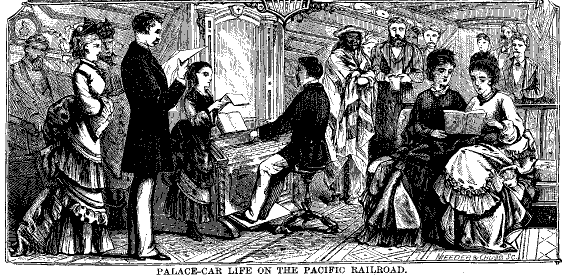
Interior Palace Car, 1877
A Palace Car was a premium service
offered by the Railroad. The cars featured plush carpeting, individual gas lamps for
the passengers, and at night, as illustrated in the next engraving, individual fold down berths.
Socializing, as illustrated in the above engraving, was conducted in the Parlor Car.
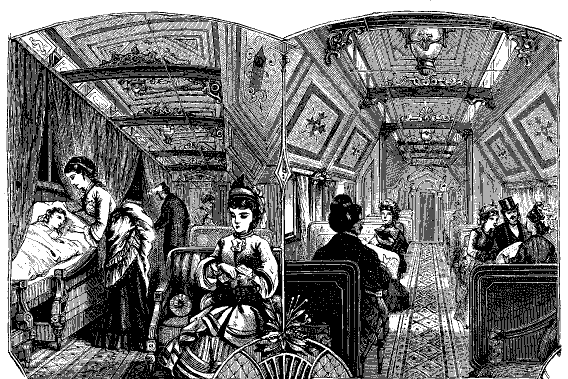
Palace Car, 1877. Left by night, right by day
Even more luxurious was the Hotel Car. In 1877, Mrs. Frank Leslie wrote in her husband's
newspaper:
You may have seen some of the sketches printed in our paper of the Pullman
Hotel Car in which we traveled. They really have the luxurious feeling of
home. Seats of plush velvet furnish the spacious living room. One party
can rent a hotel car to traverse the entire grade for a mere $120! A
well-equipped kitchen allowed us our meals cooked and served on board.
An ingenious system for running water has been installed; 20-gallon tanks
hang suspended from the ceiling of the kitchen.
Not mentioned in the newspaper was that the excursion in actuality cost a wee bit more than
$120.00. Although the hotel car was furnished by the railroad for free in exchange for
the publicity in the paper, the trip cost some $15,000.00. The hotel car, itself,
came equipped with a chef "of ebon color, and proportions suggesting a liberal sampling of the good
things he prepares." The meals were described by Mrs. Leslie in her 1877 book,
California: a pleasure trip from Gotham to the Golden Gate, as being "Delmonican
in * * * nature and style, consisting of soup, fish, entrees, roast meat and
vegetables, followed by the conventional dessert and the essential spoonful of
black coffee." The only sour note was, perhaps, the howling of the prairie
wolves, as the car passed through the countryside at the incredible speed of
20 miles per hour.
Meals, however, were not available on board for mere mortals traveling in the
Palace Cars or ordinary coaches. Meals were available in dining rooms established by
the Union Pacific in its hotels along the track. These facilities received mixed
reviews. Henry Williams wrote:
"Meals -- The trains of the Union Pacific Railroad are arranged so as to
stop at excellent stations, at convenient hours, for meals. The only
disarrangement is at Laramie, which seems to be unfortunate to passengers from
either direction. To travelers from the East it furnishes a very early supper, just after dinner at
Cheyenne, and to those from the West, it gives a very late breakfast, just before
dinner; but there is no other place for an eating-station, except at this point. At
Medicine Bow near Laramie, there is a little booth where the Western train coming
east about 7 A. M., often stops ten minutes for hot coffee, sandwiches -- an excellent convenience.
Usually all the eating-houses on both the Pacific Railroads are very excellent indeed. The keepers
have to maintain their cullinary excellence under great disadvantages, especially west of
Sidney, as all food but meats must be brough from a great distance.
Travelers need to make no preparations for eating on the cars, as meals at all dining-halls are
excellent, and food of great variety is nicely served; buffalo meat, antelope steak, tongue of all
kinds, and always the best of beefsteak. Laramie possesses the reputation of the best
steak on the Pacific Railroad. Sidney makes a specialty, occasionally, of
antelope steak. At Evanson you will see the lively antics of the Chinese
waiters, probably your first sight of them. Also they usually have nice mountain
fish. At Green River you will always get nice biscuit; at Grand Island they give all
you can possibly eat; it has a good name for its bountiful supplies."
Some diners complained that the antelope steak at Sidney was just another term for a very tough
beef steak. The facilities themselves were not operated by the Railroad, but by
concessionaires under lease. The principal operator was the Kitchen Brothers of Omaha. Charles W. Kitchen had primary
responsibility for the operation of the brothers' hotels in Wyoming, including the
Thornburg House in Laramie City, the Maxwell House in Rawlins, the Desert House in Green River City, and
the Mountain Trout House in Evanston. James B. Kitchen was responsible for the operation of the
Pacific House in St. Joseph, Mo. and Richard ran the company's properties in Omaha. The pride of the
company was the elegant Paxton House in Omaha which replaced Omaha's imposing Grand Central hotel which the brothers took
over after a foreclosure. The Paxton House was sold by Kitchen Brother in 1930. On September 24, 1878, a week before the scheduled grand re-opening of the Grand
Central, a careless workman left a burning candle in the newly constructed elevator shaft. In the resulting
confligration, the edifice was completely destroyed with five firemen losing their lives.
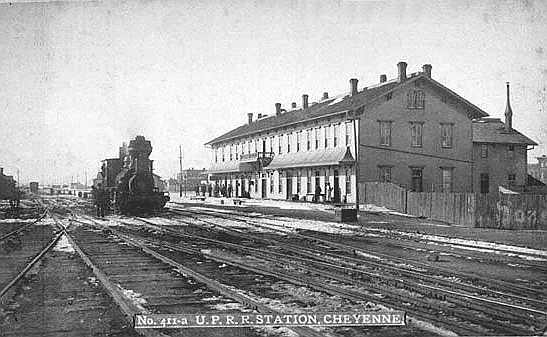
Union Pacific Depot and Hotel, Cheyenne, approx. 1880, photo by
Charles Weitfle, courtesy of Paul Weitfle, III.
It is doubtful that the rushed diners in the Cheyenne hotel had time to make note of the mounted heads of large game overlooking the
dining room from above.
The Cheyenne station was replaced in 1886 by the one pictured at the botton of the page designed by noted Boston and
Kansas City architects Van Brundt & Howe after a style promoted by Henry Hobbs
Richardson. The new terminal was one of four commissioned by Railroad President Charles Adams. The others
were the terminals in Omaha, Ogden, and Portland.
What, however, was not described by Williams was the scene at the railway station as the train paused to take on
water and coal; for the stop was only twenty minutes. The hordes of passengers scurried out of the
cars and into the station, placing their orders, and frequently having but five or fewer minutes in which
to devour the meal before the train departed. Indeed, there was the accusation that the food was
deliberately late since it was paid for when ordered. Thus, if the passenger did not have
time to eat his meal, it could be sold to passengers on the next train. Mrs. Leslie observed:
Generally, the stops to fuel and water the
locomotive are only 20 minutes long. What with having to clamber through
the ravenous crowd to first obtain one's meal, and then devouring the scant
victuals in one breath as they must, I'm sure every one of them suffers
terrible indigestion.
Owen Wister in his Lin McLean also described the waitresses and the effects of the haste with which the
meal was devoured in the twenty minute stop:
If you have made your trans-Missouri journeys only since the new era of
dining-cars, there is a quantity of things you have come too late for,
and will never know. Three times a day in the brave days of old you
sprang from your scarce-halted car at the summons of a gong. You
discerned by instinct the right direction, and, passing steadily through
doorways, had taken, before you knew it, one of some sixty chairs in a
room of tables and catsup bottles. Behind the chairs, standing attention,
a platoon of Amazons, thick-wristed, pink-and-blue, began immediately a
swift chant. It hymned the total bill-of-fare at a blow. In this
inexpressible ceremony the name of every dish went hurtling into the
next, telescoped to shapelessness. Moreover, if you stopped your Amazon
in the middle, it dislocated her, and she merely went back and took a
fresh start. The chant was always the same, but you never learned it. As
soon as it began, your mind snapped shut like the upper berth in a
Pullman. You must have uttered appropriate words--even a parrot will--for
next you were eating things--pie, ham, hot cakes--as fast as you could.
Twenty minutes of swallowing, and all aboard for Ogden, with your
pile-driven stomach dumb with amazement. The Strasburg goose is not
dieted with greater velocity, and "biscuit-shooter" is a grand word.
Writer's notes: "Strasburg goose," a goose which has been force fed to fatten its
liver; "bisquit shooter," a waitress.
The prices at the eating houses and hotels, like those in the captive eating facilities
in modern airports, also may have left something to be desired. An examination of the expense account for
a special federal agent, John T. Wallace, for August and September 1886,
reflects that dinner at Sidney cost $.75, his hotel bill in Cheyenne
(apparently including meals) was $5.65 (higher than his fees of $5.00 per day and much
higher than the average wage for a cowboy, which was slightly over $1.00 per day. It reminds the writer of a time
years ago when he was sent to Washington on business. The amount allowed on the writer's expense
account would allow him to either sleep in the hotel, or eat, but not both.), breakfast at Green River was $.75, and the hotel
in Evanston (apparently including breakfast and supper) was $3.75. In Denver,
Special Agent Wallace took the street car to the St. James Hotel. The fare was $.05, but the return to the
depot was by omnibus and cost $.25. The St. James' bill was $3.00.
Nor did Mrs. Leslie, as she supped on oyster soup, turkey, antelope steaks, quail, triffle with ice cream and cafe noir,
describe the conditions on the Union Pacific "emigrant cars." Robert Louis Stevenson took the emigrant cars and noted
that the Union Pacific cars
in which we had been cooped for more than ninety hours had begun to stink abominably.
Several yards away, as we returned, let us say from dinner, our nostrils were assailed by
rancid air. I have stood on a platform while the whole train was shunting; and as the
dwelling-cars drew near, there would come a whiff of pure menagerie, only a little sourer,
as from men instead of monkeys. I think we are human only in virtue of open windows. Without
fresh air, you only require a bad heart, and a remarkable command of the Queen's English,
to become such another as Dean Swift; a kind of leering, human goat, leaping and wagging
your scut on mountains of offence. I do my best to keep my head the other way, and look
for the human rather than the bestial in this Yahoo-like business of the emigrant train.
But one thing I must say, the car of the Chinese was notably the least offensive.
Dean Swift (1667-1745) was an Englist satirist.
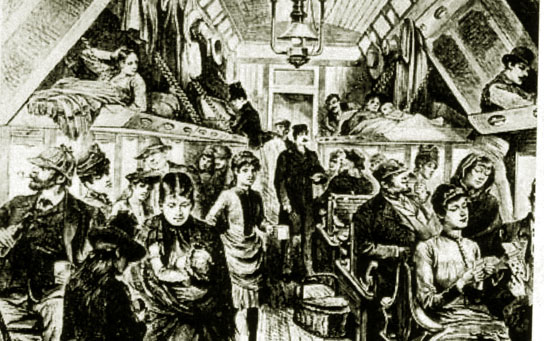
Inerior, Emigrant Car.
Emigrant Cars were hooked to slow moving local freights which would have to give way for faster moving
express passenger and stock trains. Thus, the time to cross the continent was somewhat uncertain. The seats were
made of wooden slats. Over every two seats were overhanging shelves. The shelves would be supported by chains from
the ceiling. Getting on the overhead wooden shelves required a degree of contorsion. Sleeping as the coach swayed over the uneven tracks
added to the adventure of the westerward journey.
Stevenson's educated nose was not the only one to notice the aroma of the Union Pacific emigrant cars. Charles Merritt in
1885 observed:
During the years of '82-83, the writer was in the employ of the U. P. R. R., and his run
was between Cheyenne and Laramie, in Wyoming Territory. The cars containing the emigrants
were sent over the division attached to one of the regular freight trains, and the boys of our
crew always felt bad when it was our turn to convey the "pilgrims" over our run.
The herculean aroma that emanates from an emigrant car is peculiar to itself, and can be
found nowhere else. To say that it is something like a mixture of Limburger cheese, garlic,
and a bovine in an advanced state of decomposition, is but a faint comparison, but will give
the reader a vague and shadowy idea of what it resembles.
When the wind was favorable we could smell the coming emigrant train while it was yet afar
off, and it is a noticeable fact that the vegetation on either side of the track is dead, while
cattle, sheep and even skunks, have been discovered defunct near the line of the road with no
traces of violence upon their bodies. Their demise can only be attributed to the deadly
emigrant car odor. Even after a car had stood in the yard a week, and received a thorough
scrubbing and ventillating, the fragrance was as robust as ever.
The writer remembers seeing a tough looking tramp crawl out of a box-car, just ahead of
the emigrant cars, one cold night in December, when we had to stop to pack a hot box, and
after showing strong symptoms of sea-sickness, he inquired how far it was to the nearest
station. Being informed that it was only five miles he said : "Well, I'm glad of that, but
if it was 500 miles, I would rather walk and get fresh air than to ride any further where I
was."
Individuals from every nation are to be found traveling "emigrant." Swarthy Spaniards,
chattering Chinese, burly Germans, dusky Mexicans, Indians, and in fact, representatives from
all parts of the globe. Even the dude can be met with occasionally, and he never fails to ask
the train men the cause of "that beastly odah don't ye know." Of course a great many well
educated, cleanly and respectable persons travel in this manner, but they are in the minority,
and usually arrive at the end of their journey with their nasal appendages elevated about
five degrees above their proper position.
As quoted in IX, Fireman's Magazine, 1885, p. 460.
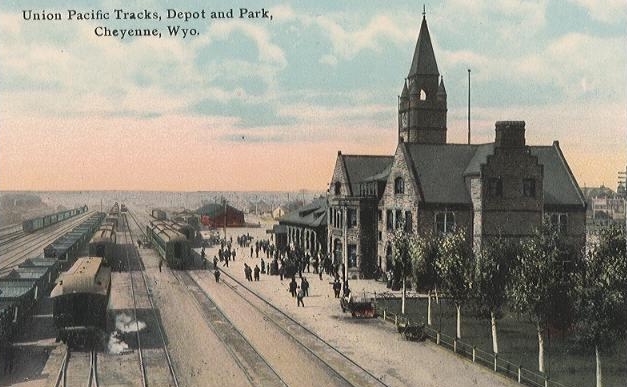
Union Pacific Depot, Cheyenne, 1910
More railroad photos are on the Laramie, Encampment, Rawlins, and Green River Pages.
|